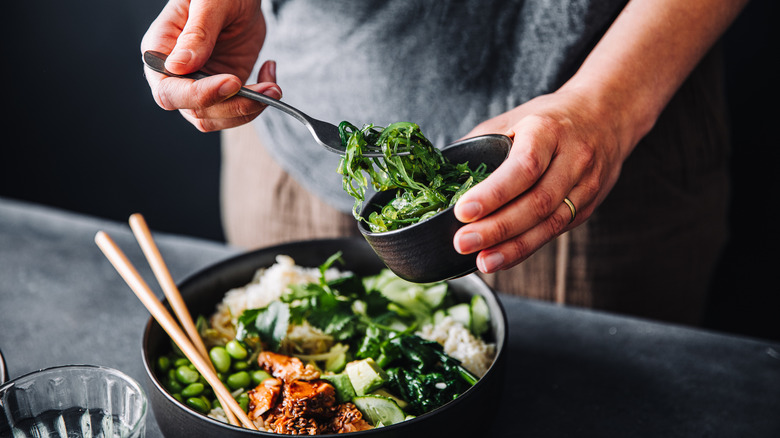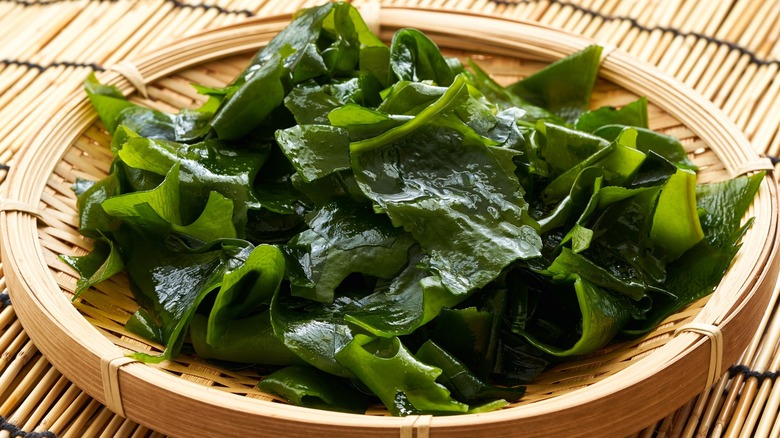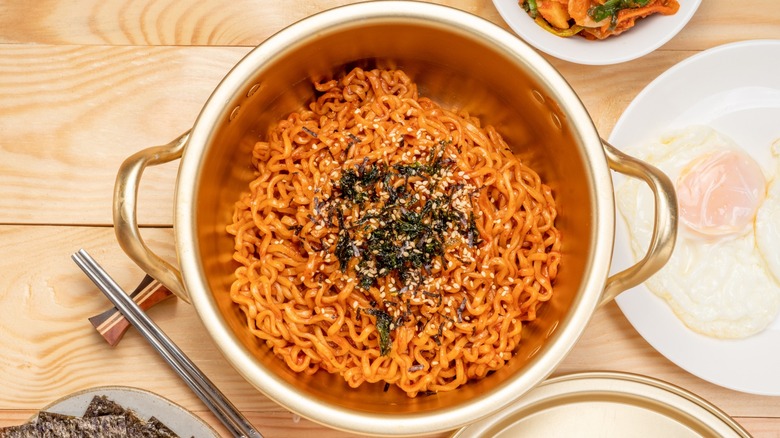Seaweed Will Give Your Stir Fry A Kick Of Umami Straight From The Ocean
A stir fry is an everything-but-the-kitchen-sink dish featuring proteins, veggies, carbs, and savory sauces culminating in a robust, satiating, and downright satisfying meal. Not only are stir fries easy to make, but they're also customizable, allowing you to try many different combinations of ingredients. Regardless of what goes into your ideal stir fry, there's one ingredient that anyone can add to theirs for an added layer of umami goodness: seaweed.
The amino acid glutamate is responsible for savory, umami-dense flavors in foods like cheese, tomatoes, and mushrooms. And while you might think that seaweed only boasts bright, oceanic flavors, it's also packed with a meaty, umami-forward bravado. Incorporating seaweed into your stir fry is an easy way to bolster the savory flavors of your dish, enhancing the meaty machismo of beef, chicken, and pork and giving plant-based stir fries, like this vegan tofu stir fry, a much-needed hit of umami. Seaweed pairs well with a wide range of other classic stir fry fixings, ensuring that you'll never have to omit or compromise on your favorite go-to stir fry provisions.
Consider the many types of seaweed
Although it may not seem like it, seaweed isn't a solitary ingredient. Like most plants, seaweed comes in many shapes, sizes, and textures, and the type you select for your stir fry can determine how it impacts your dish. Wakame is a minimally processed form of seaweed that is sold dry but typically rehydrated in dishes such as miso soup. It boasts a briny, slightly sweet, yet umami-rich flavor profile that's silky, tender, and slightly chewy.
You can rehydrate wakame by soaking it in water for a few minutes before adding it to your stir fry. Kombu is similar to wakame but is traditionally used to make broth. It's one of the most savory types of seaweed, but it has a slightly gelatinous texture when cooked (this is but one of many facts you should know about kombu). Consider cooking your stir-fried rice or noodles in a wakame broth rather than adding it whole.
Unlike wakame and kombu, nori is a type of seaweed that's been dehydrated and processed into thin, flat sheets. Although it's commonly used as a sushi wrap, you can crush dehydrated nori sheets over your stir fry for an edible garnish that's savory, salty, and satisfyingly crunchy. Dulse is another type of seaweed that is commonly sold dehydrated. However, dulse has a less marine taste than nori and is often likened to the taste of bacon — perfect for a stir fry in need of some umami depth.
Complementary seaweed stir fry ingredients
Stir fries are abundant dishes teeming with bold flavors and many different ingredients. Although seaweed pairs nicely with just about any stir fry food, there are some ingredients you can introduce to a seaweed-threaded stir fry that will enhance and complement the savory ocean plant. With its fragrant, spicy, and zippy flavor profile and aroma, ginger adds depth and complexity to stir fries that can balance the intense blast of umami from the seaweed. Because they're both plants, ginger and seaweed work together to bolster each other's earthy, vegetal taste.
For total flavor synergy, turn to seafood. Whether it's spicy sriracha shrimp or salmon, the briny, tangy, and buttery essence of cooked fish and shellfish is enhanced by the umami-rich goodness of seaweed, resulting in a more robust, full-bodied, and dynamic oceanic flavor. If you want to maximize the degree of umami in your stir fry, opt for beef, pork, or chicken instead. And if you follow a plant-based diet, look to cooking oils and condiments to discover your seaweed accompaniment.
Sesame oil has a nutty, slightly sweet, and naturally savory flavor that blends seamlessly with seaweed, imparting new yet equally bold and harmonious flavors to the dish. Top it with some umami-blasted soy sauce, and your tastebuds will rejoice. To curb any overwhelmingly savory flavors, try sweet condiments like teriyaki or sweet and sour sauce. So, next time you're cooking a stir fry, don't forget the seaweed. Nutritious, delicious, and easy to incorporate — what's not to love?


